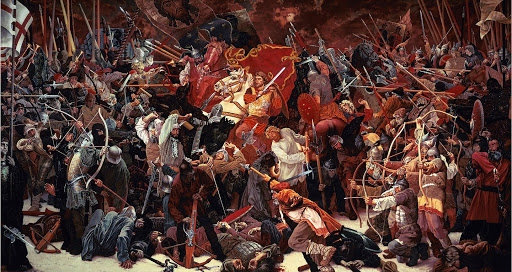Stamp: Battle of Shiloh (1862) (Grenadines of St. Vincent, Bequia 2011)
Battle of Shiloh (1862) (Grenadines of St. Vincent, Bequia 2011)
15 June (Grenadines of St. Vincent, Bequia ) within release 150th Anniversary of the outbreak of the American Civil War goes into circulation Stamp Battle of Shiloh (1862) face value 2.50 East Caribbean dollar
| Stamp Battle of Shiloh (1862) in catalogues | |
|---|---|
| Michel: | Mi: VC-BQ 734 |
Stamp is square format.
Also in the issue 150th Anniversary of the outbreak of the American Civil War:
- Stamp - Battle of Antietam (1862) face value 2.50;
- Stamp - Battle of Antietam (1862) face value 2.50;
- Stamp - Battle of Antietam (1862) face value 2.50;
- Stamp - Battle of Antietam (1862) face value 2.50;
- Stamp - Battle of Gettysburg (1863) face value 2.50;
- Stamp - Battle of Gettysburg (1863) face value 2.50;
- Stamp - Battle of Gettysburg (1863) face value 2.50;
- Stamp - Battle of Gettysburg (1863) face value 2.50;
- Stamp - Battle of Gettysburg (1863) face value 2.50;
- Stamp - Battle of Gettysburg (1863) face value 2.50;
- Stamp - Battle of Gettysburg (1863) face value 2.50;
- Stamp - Battle of Gettysburg (1863) face value 2.50;
- Stamp - Battle of Shiloh (1862) face value 2.50;
- Stamp - Battle of Shiloh (1862) face value 2.50;
- Stamp - Battle of Shiloh (1862) face value 2.50;
- Stamp - Battle of Shiloh (1862) face value 2.50;
- Stamp - Battle of the Wilderness (1864) face value 2.50;
- Stamp - Battle of the Wilderness (1864) face value 2.50;
- Stamp - Battle of the Wilderness (1864) face value 2.50;
- Stamp - Battle of the Wilderness (1864) face value 2.50;
Stamp Battle of Shiloh (1862) it reflects the thematic directions:
Animals are multicellular, eukaryotic organisms of the kingdom Animalia (also called Metazoa). All animals are motile, meaning they can move spontaneously and independently, at some point in their lives. Their body plan eventually becomes fixed as they develop, although some undergo a process of metamorphosis later on in their lives. All animals are heterotrophs: they must ingest other organisms or their products for sustenance.
A battle is an occurrence of combat in warfare between opposing military units of any number or size. A war usually consists of multiple battles. In general, a battle is a military engagement that is well defined in duration, area, and force commitment.
The horse (Equus ferus caballus) is one of two extant subspecies of Equus ferus. It is an odd-toed ungulate mammal belonging to the taxonomic family Equidae. The horse has evolved over the past 45 to 55 million years from a small multi-toed creature, Eohippus, into the large, single-toed animal of today. Humans began to domesticate horses around 4000 BC, and their domestication is believed to have been widespread by 3000 BC. Horses in the subspecies caballus are domesticated, although some domesticated populations live in the wild as feral horses. These feral populations are not true wild horses, as this term is used to describe horses that have never been domesticated, such as the endangered Przewalski's horse, a separate subspecies, and the only remaining true wild horse. There is an extensive, specialized vocabulary used to describe equine-related concepts, covering everything from anatomy to life stages, size, colors, markings, breeds, locomotion, and behavior.
A military, also known collectively as an armed forces, are a heavily armed, highly organized force primarily intended for warfare. Militaries are typically authorized and maintained by a sovereign state, with their members identifiable by a distinct military uniform. They may consist of one or more military branches such as an army, navy, air force, space force, marines, or coast guard. The main task of a military is usually defined as defence of their state and its interests against external armed threats.




